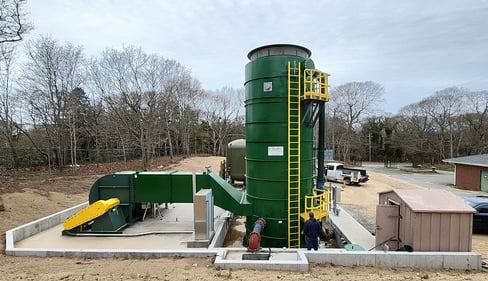
How Forced Draft Degasification Systems Work
Forced Draft Degasification (FDD) systems are at the forefront of industrial water purification technology and are designed to remove dissolved gases, such as carbon dioxide and hydrogen sulfide, from water, significantly improving water quality and reducing the risk of corrosion in industrial equipment. The process starts in a vertically designed tower where water flows downward, encountering a cross-current airflow. This setup allows the unwanted gases to be stripped away efficiently, ensuring that the water exiting the system is free of these contaminants.
The vertical tower design leverages gravity to enhance the degasification process. As water cascades downward, it passes through a series of packing materials that increase the surface area and maximize gas removal. Simultaneously, a powerful fan pushes air across the water flow, capturing and removing the dissolved gases. This dual-action mechanism makes FDD systems highly effective and reliable for industrial applications.
The Economic Advantages of Using FDD Systems
One of the standout benefits of Forced Draft Degasification systems is their cost-efficiency. From both a capital investment and operational perspective, FDD systems offer significant savings. Their high removal efficiency, which can reach up to 99.999%, means that industries can extend the lifespan of their cation and anion exchange resins, reducing the need for frequent replacements and chemical additives. This translates to lower ongoing costs and less operational downtime.
Moreover, the initial capital cost of installing an FDD system is generally lower than that of alternative methods like liquid cell degasification. FDD systems operate with minimal energy consumption, making them not only cost-effective but also environmentally friendly. The reduced energy requirements lead to lower utility bills, further enhancing the economic appeal of these systems. Additionally, the minimal maintenance requirements mean that industries spend less on upkeep, making FDD systems a smart long-term investment.
Environmental Benefits: Energy Efficiency and Reduced Footprint
In addition to economic advantages, Forced Draft Degasification systems offer significant environmental benefits. Their low energy consumption is a key factor, as they require far less power to operate compared to other degasification methods. This reduced energy usage translates to a smaller carbon footprint, making FDD systems an attractive option for industries committed to sustainable practices.
Furthermore, FDD systems contribute to a cleaner environment by minimizing the need for chemical additives. By efficiently removing dissolved gases without the use of harsh chemicals, these systems generate less chemical waste, reducing the overall environmental impact. The combination of energy efficiency and lower chemical usage makes FDD systems a green choice for industrial water purification.
Navigating the Complexities of FDD System Design
Despite their numerous benefits, Forced Draft Degasification systems do come with certain complexities, particularly in the design and calculation phases. Achieving maximum removal efficiency requires precise engineering and careful planning. Incorrect design can lead to issues such as hydraulic flooding or channeling, which can severely diminish the system's effectiveness and increase operational costs.
To navigate these challenges, it is crucial to engage with experts who have specialized knowledge in FDD system design. Properly sizing the tower, selecting the right packing materials, and ensuring optimal airflow are all critical factors that contribute to the system's success. While the initial setup and installation can be time-consuming, investing in a well-designed system pays off in the long run through improved performance and reduced operational issues.
Comparing FDD Systems to Alternative Degasification Methods
When evaluating Forced Draft Degasification systems against other degasification methods, several factors come into play. Chemical treatments offer a straightforward approach to removing contaminants but often involve higher operational costs and potential environmental hazards. Liquid cell degasification, while effective, demands a significantly higher capital investment and consumes more energy, making it less favorable for cost-conscious industries.
Membrane degasification is another alternative, known for high removal rates. However, this method can be cost-prohibitive and requires regular maintenance, adding to the overall expenses. In comparison, FDD systems strike a balance between cost-efficiency, high removal efficiency, and minimal maintenance, making them a compelling choice for many industrial applications.
Expert Insights: Making the Right Choice for Your Industry
While Forced Draft Degasification systems offer numerous advantages, some experts advocate for alternative methods based on flexibility and adaptability. Chemical treatments, for instance, can be easily tailored to handle a wide range of contaminants, providing versatility for varied industrial applications. These methods often require less specialized knowledge, making them accessible for smaller operations.
Experts also highlight the potential challenges associated with FDD systems, such as the need for precise design and the risk of operational issues if not properly implemented. The initial design and setup costs can be a barrier for some industries, particularly those looking for a more straightforward solution. Therefore, it is essential to consider the specific needs and circumstances of your operation when deciding on the best degasification method.
Making an Informed Decision: What to Consider
Choosing the right degasification method for industrial water purification involves weighing the pros and cons of each option. Factors such as initial capital cost, operational expenses, maintenance requirements, and the specific contaminants to be removed are crucial considerations. While Forced Draft Degasification systems offer significant advantages in terms of cost-efficiency and energy consumption, their complexities may not be suitable for every application.
Consulting with the experts at DeLoach Industries, Inc., or by calling 941-371-4995, can provide valuable insights and help you make an informed decision. Whether you opt for a Forced Draft Degasification system or an alternative method, understanding the strengths and weaknesses of each option will ensure you achieve the best results for your industrial water purification process.



